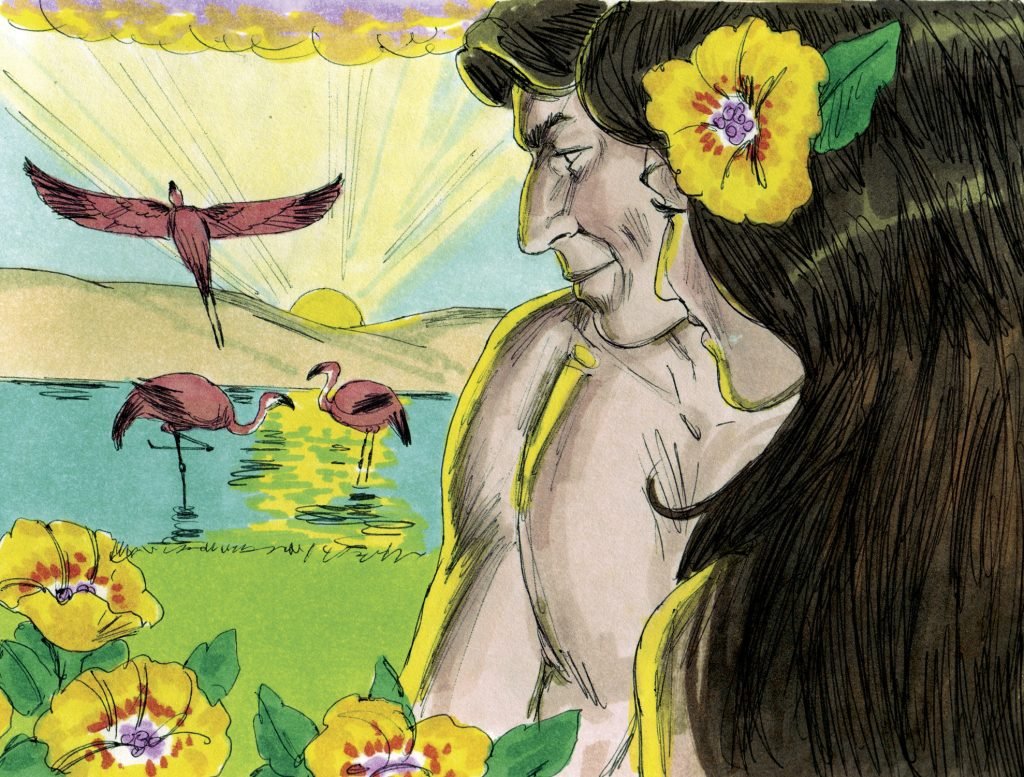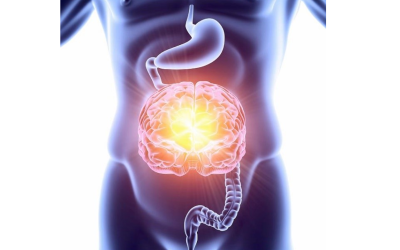This article is Part II of a series of articles (Part I) in which I will demonstrate how I am taking scriptural archetypal maternal figures such as Eve (of the Garden of Eden) and translating the mystical qualities and symbolism associated with these mythical mothers into essential oil selections for inclusion in the Maternal Essence blend.
In this article I will reveal the first 6 of the 13 oils in the Maternal Essence blend. This will provide you a rare glimpse into how the inner meaning of spiritual archetypes can be translated into essential oil selections for the purpose of deep soul-level exploration and development.
The remaining articles in this series (in which I will reveal the other 7 oils, discuss the selection process and share the precise proportions of the oils in the blend) will be mailed only to those readers who are registered in my SPE/NHSS Practitioner Membership Program. Part III of this series, focuses on the central New Testament maternal archetype, Mary (the mother of Jesus) and relevant essential oils.
Maternal Essence Blend
As discussed in previous issues of this journal, I have designed a collaborative blending project for the attendees of my Essential Oils And Soul 3-Class Teleseminar Series that is certain to be a source of very deep inner connection and soul-to-soul relation. My intent is to not only help improve the students’ blending skills but also to take them into the heart of soul-level healing work with essential oils.
The students are being taught in a step-by-step manner how a soul-level essential oil blend is designed, formulated, blended and used. This blend will not only serve as a unique Mother’s Day gift but also, via personal use of the blend, as a catalyst for targeted, deep soul-level exploration.
The Maternal Essence blend can be prepared every year to mark Mother’s Day or can be used throughout the year in accordance with the dynamics of one’s individualized journey inward toward the root of his or her soul.
This blend will not simply reflect a Norman Rockwell image of Mom and apple pie, although certainly that element of maternal nurturing will be encoded into the blend’s inner meaning. In addition to this nurturing theme and other central elements of the mother/child relationship such as birthing and maternal understanding and guidance, the symbolic and mystical qualities associated with particular maternal archetypes will serve as nuclei for the development of the blend.
Selective Perspectives Regarding Eve: Archetypal Maternal Figure #1 for Blend Development
The story of Adam and Eve is a familiar one to most people and so does not require a complete recounting. Our goal here is to come to an understanding of certain compositional archetypal elements of Eve, that the Jewish mystics were both revealing and veiling through allegory and symbolism, and translate these elements into essential oil correlates. Toward this goal, I have selected specific aspects of the Garden of Eden story as it relates to Eve to serve as focal points for the selection of specific essential oils for the Maternal Essence blend.
The Garden of Eden and Eve

“God created the heavens and the earth. He created all the animals on the land and in the sea. He created the birds, the plants, the sun, and the moon. He created light and darkness. He created man, Adam. Adam named all the animals. Adam was alone. God realized that it was not good for Adam to be alone, so he created Eve. He fashioned her from a rib in the side of Adam. They lived in the Garden of Eden and were without sin. God told Adam and Eve that they could eat fruit from any tree in the garden but one. Satan took on the form of a serpent and convinced Eve to eat from the tree of forbidden fruit. She in turn, convinced Adam to do the same. Adam and Eve were immediately ashamed of their nakedness and their disobedience. They used leaves to cover themselves and hid from God. Their disobedience angered and saddened God. He sacrificed an animal to cover their sin and their nakedness. He told them they would forever toil and experience pain and trouble, both them and their heirs. He condemned the serpent to always slither the earth on its belly and forever be at odds with humans. He banished Adam and Eve from the Garden of Eden. The Bible Art Library is a collection of commissioned biblical paintings. During the late 1970s and early 1980s, under a work-for-hire contract, artist Jim Padgett created illustrations for 208 Bible stories encompassing the entire Bible from Genesis through Revelation. There are over 2200 high-quality, colorful, and authentic illustrations. The illustrations are high quality, biblically and culturally accurate, supporting the reality of the stories and bringing them to life. They can be used to enhance communication of Bible stories in printed, video, digital, and/or audio forms.”
Eve appears early on in the Book of Genesis and is indisputably the first mother to appear in the Torah. This alone gives us some general direction in terms of oil selections. However, if we are determined to develop a blend which opens a doorway into the deeper precincts of the soul, we have to penetrate the rich symbolism in the Garden of Eden story and mine insight into the inner essence of Eve which leads us to the realm of spirit.
About ten years ago I came across the book God, Sex and Kabbalah by Rabbi Allen S. Maller. The book covers a lot of territory, but for me Rabbi Maller’s discussion of the inner meaning of the story of the Garden of Eden and Eve provided particularly thought-provoking insight. Thus, in Part II of this series I am presenting excerpts from that discussion and demonstrating the process by which I used these to lead me to the selection of key essential oils for inclusion in the Maternal Essence Blend.
The following section features selected excerpts from God, Sex and Kabbalah interspersed with my commentary that demonstrates how I Rabbi Maller’s insights lead me to essential oil selections.
Please note: In my corroborations of the oil selections below, I reference rubrics selected from my Spiritual PhytoEssencing Repertory Of Essential Oils. To learn more about this invaluable tool, how to use it and why it makes the oil selection process so much more concise and organized click on the link within this paragraph. You will note that in this article, the oil I selected is highlighted and underlined within the supportive rubrics (a rubric consists of a title, usually a characteristic or symptom, with all relevant oils listed alphabetically below it).
When two rubrics are used to support a given oil selection, you will find that the oil is listed in both rubrics. Cross-correlating rubrics in this manner helps to more quickly identify essential oils which may qualify for inclusion in a blend.
The descriptive excerpts corroborating each oil selection are taken from the central reference text of Spiritual PhytoEssencing, Berkowsky’s Synthesis Materia Medica/Spiritualis Of Essential Oils which to date consists of fully elaborated profiles 120 chapters, covering 120+ different essential oils. These chapters (e-mailed as PDF documents) can be purchased individually or as a complete set.
Excerpts from God, Sex and Kabbalah, Interpretation and Oil Selections
Excerpt #1
“The story of the Garden of Eden is one of the most misunderstood and misinterpreted allegories in the history of mankind…First of all, at the end of the allegory, God says: “Man has become as one of us to know good and evil.” The Torah is saying that mankind became like God by eating from the Tree of Knowledge of Good and Evil and so, like God, came to know Good and Evil. That is that at the end of the allegory, mankind became more like God than it had been at the allegory’s beginning. This indicates that the allegory is not about the fall of mankind but about the rise of mankind’s awareness.” –Rabbi Allen S. Maller
The story of the Garden of Eden is most commonly portrayed as a sort of tragedy in which two human beings disobey God, are expelled from paradise and come to experience the myriad tribulations of mortal life including death.
This moralistic interpretation is at best limited in that the most important outcome of the story is the advent of Self-consciousness and free will. Without separation from God and the infinite realm, human beings cannot exert free will.
The sages teach that one of the rationales for God’s creation of the finite realm was to enable human beings to freely acknowledge and choose to love God. In other words, God like his children, desired to be loved and acknowledged. Love and acknowledgment are only meaningful if they are the product of free will.
Therefore, Eve, rather than being a fallen women who had succumbed to temptation, is actually the facilitator of the free will that is the prerequisite for faith, knowledege, courage, real love and the opportunity for each person to uniquely individualize his or her own soul.
Selected Relevant Rubrics from Spiritual PhytoEssencing Repertory of Essential Oils:
WILL
Basil; bitter orange peel; black pepper; blue cypress; cardamom; caraway; cassie; catnip; cedarwood; celery seed; cilantro; clary sage; coriander; davana; Douglas-fir; elemi; fennel; geranium; ginger; goldenrod; grapefruit; guaiac wood; hemp; juniper; lemongrass; marjoram; myrrh; neroli; olive; patchouli; ravensare; rose; rosemary; spikenard; tagetes; tarragon; thyme; vetivert; yarrow; ylang ylang
INDEPENDENT
ammi visnaga; balsam poplar; benzoin; black pepper; black spruce; blue cypress; catnip; cedarwood; celery seed; clove; cypress; Douglas-fir; elemi; eucalyptus; frankincense; helichrysum; hemp; monarda; myrtle; parsley; peppermint; rose; rosewood; silver fir; yarrow;
Oil Selection: Cedarwood
The themes of faith, will, strength and security run throughout the cedarwood oil picture. In the same way that individual will is an individuated extract of Divine Will, faith in oneself is a derivative of the super-rational faith in God. In the success state of cedarwood, the individual functions with faith in God, herself (or himself) and her life-partner, manifests inner strength, strong will and a sense of security. Hence, qualities such as: selflessness and sweetness; tendency to sacrifice or give of themselves for others; sympathetic; cheerful even when sad; suffers in silence with dignity; marked degree of gaiety; refined and dignified; independent; self-sufficient; well-organized; sincere; honest; straightforward; non-manipulative; always ready to help others.
Excerpt #2
“In Hebrew, adam is not a name, but the word for mankind or humanity. Adam was adopted as a name by later generations, but in the Torah always refers to mankind. Eve, which means Life-giver, refers to the special unique power of women to give birth to new life…It is due to this special quality that Eve came to eat of the fruit of the Tree before Adam.” –Rabbi Allen S. Maller
Life-giver refers not only to birthing in the literal sense but also to the enabler of the soul life, which if navigated as a conscious being, leads to personal wholeness and contribution to tikkun olam– the repair of the world.
Selected Rubric from Spiritual PhytoEssencing Repertory of Essential Oils:
BINAH-UNDERSTANDING, Tree of Life vessel of:
black spruce; calendula; carrot seed; cistus; cumin; davana; dill; eucalyptus; fennel; frankincense; ginger; grapefruit; jasmine; laurel; lemongrass; melissa; myrrh; myrtle; neroli; nutmeg; oakmoss; patchouli; peppermint; rose; seaweed; silver fir; St. John’s wort; thuja; yarrow
Oil Selection: Carrot Seed
Binah is viewed as the “Upper Mother.” Within this context, Binah is the full expression of the creative power of femininity. It is both receptive (to the stream of Supernal Light which enters it from above) and incessantly giving birth to the externalization of the Divine Energy which sustains the seven lower vessels of the Tree of Life.
Binah emits these sefirot (vessels) from herself and realizes her strength in them. For this reason, Binah is viewed as the “mother” of the seven sefirot below her. Binah shapes the emanations she has received, like a mother forming and guiding her offspring.
Each of the lower seven vessels correlates with a day of Creation. Hence, Binah is essentially the “Mother of the Universe,” as the Divine Light processed and channeled to the lower vessels by Binah facilitates the growth and development of the physical world. Binah, the prototype of the wise mother, is the seat of understanding, judicious restriction and objective judgment.
Dr. Norman Walker, perhaps the greatest authority on the therapeutic use of raw vegetable juices, encouraged nursing mothers to drink carrot juice to enrich their milk, and Dr. W. Kubler suggests supplementing a baby’s diet of mother’s milk with carrot juice as a means of enhancing utilization of vitamin A (necessary for clear vision). Carrot seed oil is considered useful for increasing the flow of breast-milk.
Clearly, the carrot has a unique affinity for the breast and breast-milk. When considering this, I found that the emotional profile of the carrot seed oil type, not unexpectedly, has some striking parallels with the picture of the homeopathic remedy Lac humanum., prepared from human breast-milk. The strong essence of Binah in carrot seed oil provides support to help ameliorate feelings of insecurity and vulnerability.
Excerpt #3
“The Torah uses the image of eating to make the concept of internalizing knowledge dramatic and vivid…The allegorical consumption of the fruit of the Tree of Knowledge of Good and Evil symbolizes humanity’s internalization of the values of Good and Evil.
The true meaning of the Garden of Eden allegory tells us that humanity originally could be compared to infants who lack moral knowledge of right and wrong. As the years go by and the children grow, they begin to understand right and wrong. At length, they internalize the Knowledge of Good and Evil; they acquire the sense of morality. Before the fruit of the Tree of Knowledge of Good and Evil was consumed, humanity was in the amoral state of nature. Although people could disobey God’s commandments, they could not sin. God did not punish humanity for disobedience, because God did not hold humanity responsible for its acts.” –Rabbi Allen S. Haller
Selected Rubrics from Spiritual PhytoEssencing Repertory of Essential Oils:
BINAH-UNDERSTANDING, Tree of Life vessel of:
black spruce; calendula; carrot seed; cistus; cumin; davana; dill; eucalyptus; fennel; frankincense; ginger; grapefruit; jasmine; laurel; lemongrass; melissa; myrrh; myrtle; neroli; nutmeg; oakmoss; patchouli; peppermint; rose; seaweed; silver fir; St. John’s wort; thuja; yarrow
GOLD THEMES
bitter orange; calendula; carrot seed; goldenrod; helichrysum; lemongrass; lovage; mastic; neroli; niaouli; Roman chamomile;
Oil selection:Corroboration of carrot seed oil
In Spiritual PhytoEssencing, carrot seed oil is considered a “gold oil.”
The central themes and properties of the homeopathic remedy Aurum (potentized gold) which can serve as a template for the gold oils include: wants to be treated with respect; responsible attitude; hardworking; conscientious about trifles; feelings of having neglected his duty and so he deserves reproach and is not worthy of salvation; anxiety of conscience; anxiety about salvation; lack of self-confidence; wants to hold on to power; personal leadership cannot be shared; brooding; terribly offended when criticized for what is perceived as being personal failure; depression if one cannot live up to one’s own expectations-feels a failure and fully takes on the fault of it; very strong parental influence, thus, judges things based upon the perspective his parents have imbued him with.
Excerpt #4 (Torah excerpt)
Genesis 3:6: “The woman saw that the Tree was good to eat, and desirable to the eyes, and that the Tree was to be desired to gain intelligence, she took of its fruit and ate it.” –The Living Torah by Rabbi Ariel Kaplan
Oil Selection: Ginger
The Kabbalah teaches that eating is essentially a mixed animal/ spiritual function. Eating is one of the 3 primary “lusts.” The other two being lust for wealth and sexual lust. However, eating is the most basic because it is present at birth, and it’s also the lust that provides the energy to pursue all other desires. If one eats with gluttony, or food lust, he eats animalistically.
The Hebrew word for bread which is the “staff of life” is lechem, and the word for war is lochem. Kabbalists take this to mean that eating is in effect a battle between the animal and the spiritual in us, or the astral and spirit bodies. If one eats with an understanding that the food comes from a higher source, eating will enable him to reach a higher level of perception.
Eating “animalistically” leads to illness, a forfeit of higher knowledge, subjugation to inappropriate desires and fears, domination by materialistic forces and focus on the mundane rather than the spiritual. Hence, there must be a balance between the physical gratification and spiritual benefits of eating.
The more spiritual our motivation when we eat, the more spiritually nourishing our food becomes. However, over-stringency in eating, which excessively denies physical gratification, starves the “animal” in us and leads to depression.
While ginger oil supports the more animalistic side of eating, its encouragement of spirit body integration into physical life strikes just the right balance. It helps to sharpen the mind, memory and senses, and cheer those who are emotionally worn out. On one hand, it heightens sexual interest (an animal soul quality) while on the other, it supports transformation and enlightenment (higher soul qualities). It also encourages acceptance where previously there has only been an urge for struggle and fighting (i.e., balances higher soul and animal soul inclinations).
Excerpt #5
“Thus Eve gained Knowledge of Good and Evil. After she gained the Knowledge of Good and Evil, she gave it to Adam and he also ate. It is important to recognize that the woman took the fruit, not because she was curious like a baby, but because she desired to be wise. She wished to become like God. The fruit of the Tree of Good and Evil, moral knowledge is the difference between humans and other animals…Animals have physical attributes [astral body], but they lack knowledge of morality. God has moral knowledge but no physical attributes. Humans alone in this world are both like animals and like God. They are physical beings possessing moral knowledge.” –Rabbi Allen S. Haller
Selected Relevant Rubrics from Spiritual PhytoEssencing Repertory of Essential Oils:
DAAT-KNOWLEDGE, Tree Of Life Vessel of:
black spruce; blue cypress; cardamom; cinnamon; clove; melissa; patchouli; peppermint; rosemary; sage; silver fir; spikenard; tagetes; violet;
TIFERET-Beauty/Harmony, Tree of Life, vessel of
basil; blue chamomile; blue cypress; cacao; calendula; cardamom; Douglas-fir; frankincense; geranium; helichrysum; juniper; laurel; lavender; marjoram; monarda; oregano; orris root; palmarosa; patchouli; peppermint; pine; Roman chamomile; rosewood; sage; sandalwood; spikenard; valerian;<
Selected Oil: Australian blue cypress
Blue cypress is a specific for the interface of the sefirot (Tree of Life vessels) of Daat-Knowledge and Tiferet-Beauty/Harmony. Daat is the external intellectual manifestation of volition and identity which is communicated to the world. Daat is the ability to express one’s intelligence to others. The Talmud defines a deaf-mute as someone lacking Daat. However, as soon as this individual develops the capacity for sign and/or written language, he is considered to have Daat. Thus, Daat is the ability to communicate and develop an intelligent relationship with the outside world. Tiferet helps one to move forward with a balanced equation of compassion and strength, and thus, find his or her way toward a peaceful and meaningful existence. Tiferet allows one to give of oneself while maintaining essential personal boundaries. Tiferet is also linked to meaningful speech and a sense of truth. Hence, it is the spiritual root that ensures that, when fully active, we are being honest with ourselves.
Excerpt #6“When Adam consumed the fruit, it was not with the same motivation that Eve had. So man cannot receive the same credit for bringing mankind into the civilized state of law, social responsibility and morality. Thus, the Torah teaches that the woman has been the mother of morality and civilization…It is through Eve, mother, that all the children of mankind learn morality.” –Rabbi Allen S. Haller
This is further supported by comparison to Adam’s peevish, blaming, child-like response to God’s query (Genesis 3:11 – 12): “Did you eat from the tree which I commanded you not to eat? The man replied: �The woman that you gave to be with me-she gave me what I ate from the tree.’” Selected Relevant Rubrics from Spiritual PhytoEssencing Repertory of Essential Oils:
BINAH-UNDERSTANDING, Tree of Life vessel of:
black spruce; calendula; carrot seed; cistus; cumin; davana; dill; eucalyptus; fennel; frankincense; ginger; grapefruit; jasmine; laurel; lemongrass; melissa; myrrh; myrtle; neroli; nutmeg; oakmoss; patchouli; peppermint; rose; seaweed; silver fir; St. John’s wort; thuja; yarrow
GEVURAH-STRENGTH/JUDGMENT, Tree Of Life, vessel, of:
basil; hyssop; lemon; melissa; myrrh; thuja;
Selected Oil: Myrrh
See above, discussion of Binah in relation to carrot seed oil.
The Sefirah of Gevurah-Stength/Judgment is associated with restraint, barriers, the limitation of free-flowing grace. Gevurah guides us to maintain our borders and hold back. In the creation process Gevurah emanated from Binah. Binah is considered to be the origin of the level of the soul known as Neshama-the level where the soul of each individual assumes a unique, separate identity. On this level, one becomes aware not only of spirituality, but also, develops an intimacy with his or her source. Neshamah is associated with meaningful thought and a sense of the ideal. Gevurah receives emanations from Binah above and together with its own understanding forms a judgment. This judgment power is required to destroy lies and disease. Wealth and sustenance flow from Gevurah with the help of Binah. Myrrh was said to have been mixed in wine and given to Jesus as he was dying, and calling in anguish to God, upon his crucifix. It is through the Binah-Gevurah linkage, that myrrh helps reconnect an individual to the flow of Supernal Light and Understanding. Gevurah strengthens commitment to the eternal through its power for helping one overcome obstacles.
Excerpt #7“Eve ate from the Tree of Knowledge of Good and Evil because she wanted the wisdom to understand both the meaning of birth and creativity, as well as the meaning and function of death, in the scheme of life. This is why she is referred to as the woman all during the story, and only after she has eaten of the fruit of the Knowledge of Good and Evil and after God has promised her that she will bring forth children does Adam call her Eve.” – Rabbi Allen S. Haller Selected Relevant Rubrics from Spiritual PhytoEssencing Repertory of Essential Oils:
CREATIVITY
bergamot; bitter orange peel; black pepper; carrot seed; davana; geranium; hemp; jasmine; laurel; marjoram; myrtle; olive; pine; rose; rosewood; sandalwood; seaweed; silver fir; tagetes; thyme; vetivert; violet; yarrow
DEATH, THOUGHTS OF
angelica; balsam poplar; basil; bitter orange peel; blue chamomile; cajuput; calendula; camphor; carrot seed; celery seed; cilantro; cistus; cypress; davana; echinacea; eucalyptus; frankincense; geranium; ginger; goldenrod; guaiac wood; helichrysum; hemp; hyssop; ledum; lemon; melissa; myrrh; neroli; niaouli; patchouli; peru balsam; pine; ravensara; roman chamomile; sage; sandalwood; seaweed; st. john’s wort; tagetes; tarragon; thuja; thyme; turmeric; vetivert; violet; yarrow;
Each day the faithful, as a way of expressing their love and devotion, place davana cuttings on altars dedicated to Shiva. The flowers remain there until they are removed at the end of the day. Some believe that the name davana derives from the goddess Dhavanam, a deity closely associated with Shiva. Shiva is one of the principal deities of Hinduism. In Hinduism, Brahma, Vishnu, and Shiva, known collectively as the Trimurti, each represent one of the three primary aspects of the divine. Accordingly, Brahma is the creator, Vishnu is the maintainer or preserver, and Shiva is the destroyer or transformer. Shiva represents the aspect of the divine associated with the dissolution that allows for renewed creation within the cyclic process of creation and dissolution of the universe. Davana oil reconnects one to his or her creative energy and intuition in part, via grounding and opening to spiritual consciousness, which actions respectively represent healing within the root chakra and revival of the Desire To Receive the waters of light which is required to illuminate the way to the beginning of oneself.
First 6 oils in the Maternal Essence blend: cedarwood, carrot seed, ginger, Australian blue cypress, myrrh and davana.






